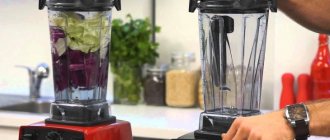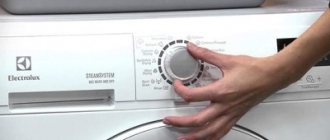A drip coffee maker is a type of coffee machine that can be used to prepare a drink at home or in the office. But in order for the coffee to taste good and for there to be no problems with the machine, you need to understand how this system works. It is also worth carefully studying the instruction manual and learning how to use a drip coffee maker, since there are simple budget models and more modern equipment with smart functions controlled via an application on a smartphone.
How to use a drip coffee maker
The operating principle of drip coffee makers has not changed since the invention of this method of preparation. However, many manufacturers have modernized the design of coffee machines, adding various useful functions and making it easier to clean the device after use. The classic operating principle of a drip coffee maker:
- The body of the coffee maker has a water tank and a boiler - when the device is turned on, the liquid is heated to a temperature close to +90...+95ºC.
- The heated water rises up the drip tube and drips onto the ground coffee placed in a special filter.
- Seeping through the ground grains, the liquid takes away the taste and aroma, and then flows into a cup or reservoir for the finished drink.
All the grounds remain in the filter, and only the finished coffee goes into the container. Most modern devices have additional heating for the drink container to maintain the temperature for a while. The system is equipped with an automatic shutdown function. Depending on the manufacturer, the device may be equipped with a built-in coffee grinder or other pleasant additions.
Types of coffee machines
All coffee machines differ from each other in design and functionality. They can be equipped with a cappuccino maker and perform almost all necessary operations automatically. According to their qualities, coffee machines are divided into several categories:
- Standard coffee machines . As a rule, these cars are included in the budget segment. Most of them do not have a cappuccino maker, so drinks with milk cannot be prepared. Almost all have built-in coffee grinders, which distinguish coffee machines from regular coffee makers.
- With manual cappuccino maker . This function is performed by a separate tube equipped with a special nozzle for supplying hot steam. The panarello nozzle expands the steam stream, accelerating the formation of foam. The main disadvantage is the need to manually froth the milk. Although this process is quite easy, it is time consuming. Thus, in these coffee machines, the foam is first created manually, and only after that it is used for its intended purpose. However, coffee machines with a manual cappuccino maker allow you to save a lot of money when purchasing, especially when you plan to prepare dairy drinks not very often.
- With automatic cappuccino maker . These are already more advanced and functional coffee machines. The required dosage of milk is determined and measured automatically. It is possible to select the sequence of mixing cappuccino ingredients. The only manual action is to move the cup of coffee under the frothed tube. In many machines, the milk container is made removable and stored in the refrigerator until ready.
- Superautomatic machines . The most expensive machines capable of preparing the most delicious coffee drinks. Wide functionality covers almost all work processes and brings them into automatic mode. The coffee beans are only poured in manually, water and milk are poured in. After this, the required mode is selected and all that remains is to wait for the final result. All containers for grains and liquids are large and do not require frequent refills. In expensive and professional models you can even prepare hot chocolate and other exotic products.
Philips
Philips produces different models of drip coffee makers. There are simpler models that can prepare a drink in its classic version from pre-ground coffee. But coffee machines with a tank for beans and the ability to adjust the grind are more popular. The features of this technique are:
- Built-in conical coffee grinder with a choice of 3 grinding levels.
- Possibility to disable the grinding function to use pre-prepared powder.
- Some models have 2 grain tanks with the ability to mix different varieties in any proportions.
- Drip-stop function – the ability to pause the preparation of a drink and pour a cup of coffee separately.
Attention!
The specific functionality and location of the main controls and buttons are described in the manufacturer’s instructions for each individual model of coffee maker.
Geyser models
They are different. There are coffee makers that operate from the mains, and there are those that are placed on an electric or gas stove. Water is supplied upward (based on the geyser principle). The liquid pours into the coffee mass, after which it is poured into another container.
The geyser coffee maker is small. It looks like a porcelain coffee pot, which consists of two parts. The two compartments are connected to each other like a simple hourglass. The center of one of the containers is narrow, it is intended for coffee mass. When water boils below, it begins to rise. Rising through the narrowed channel, the water brews the drink, and it enters the upper part of the coffee maker.
Tefal
Of the most popular drip coffee makers from the Tefal company, there are 2 models - Principio and Express. These coffee machines are equipped with automatic shutdown systems, drink strength adjustment and a water level indicator in the tank. Their operating principle is as follows:
- water boils in the boiler;
- through the tube it falls onto the ground coffee;
- The drink seeps drop by drop through the filter into the container.
When the preparation process is completed, the heating is turned on under the coffee pot with the drink. It runs for approximately 30 minutes. This way the coffee can remain suitable for drinking for a long time. The Tefal coffee machine also comes with a reusable plastic filter that can be cleaned after use. Adjustment of the strength of the drink is ensured by changing the speed of water supply - the slower, the richer and more aromatic the coffee will be.
Design of a carob coffee machine
Carob coffee makers got their name because of the special nest designed for filling and compacting coffee powder. The element itself is known as a horn or holder. The second name is used by foreign coffee lovers. Devices can be single- or double-horned. The latter refer to semi-automatic and high-volume automatic machines.
The main components of the device are:
- Water pump. It supplies water to the circuit, including the heating boiler.
- Boiler. This is where the water is heated to the desired temperature.
- Pressure switch and pressure sensor. They protect the boiler from rupture from excess pressure and overheating.
Externally, the horn resembles a strainer with a handle. Together with the coffee powder, it is inserted into the brewing group, where the water heated in the boiler is distributed. Steam enters a special spout and whips the milk to a thick foamy consistency.
Most machines come with a warming rack, a display, function buttons, and other useful controls. In general, this is too general and simple a description, since different models may have several holders, boilers and dispensing groups. They differ in case material and the presence of a variety of additional functions.
Redmond
The models of coffee machines from this manufacturer are mainly classified as high-end. The device is equipped with an automatic on/off system with a timer. When the drink has finished brewing, the drip coffee maker beeps three times and goes into standby mode. The volume of the water tank is about 1.5 liters, so with a full set of coffee it will not be possible to achieve the optimal strength of coffee - the size of the filter container does not allow it to accommodate the required amount of ground beans.
The Redmond coffee maker is equipped with an anti-drip system - it does not leak from the nozzle after brewing. This will not completely avoid stains on the heating plate, but it will reduce the number of such marks to a minimum. The panel is additionally equipped with a display with a clear image. But the screen is not backlit, so it is inconvenient to use. However, the classic light indication is quite bright.
Grinding beans
To make espresso you need a very fine grind. Thereby:
- the surface area of contact with water increases,
- wetting is accelerated,
- Sufficient resistance is maintained to establish the desired water flow rate.
Make sure there are no lumps in the powder.
It is better to grind coffee immediately before preparation.
This allows you to retain more aromatic oils. And studies have also shown that half of the CO2 was released five minutes after grinding. CO2 is needed for more proper filtration and coffee foam.
Bosch
The Bosch line of kitchen equipment includes separate models of drip coffee makers. The most common series are CompactClass Extra and ComfortLine. Their main features are:
- mechanical control;
- anti-drip system;
- acceptability of disposable filters;
- Possibility to adjust the strength of the finished coffee.
Additional features include SafeStorage technology for safe storage of the coffee pot, and Aroma+button for increased richness and aroma of the finished drink. There is a measuring scale on the glass coffee container. Depending on the model, the volume of the finished drink can be either up to 1.25 liters or up to 1.4 liters. There are similar markings on the water tank.
Questions and answers
What are the proportions of coffee and water for espresso?
Italian version
A typical serving is 7 grams per 30 ml shot. 14g - for a double shot of 60 ml.
Regular espresso in Italy is called "normale".
American version
In the States, large volume coffee drinks are popular and they use more coffee. Therefore, American baristas use up to 14 grams of coffee to brew one shot. And the volume continues to increase.
They say that it was in the USA that the triple shot appeared.
Interestingly, due to increasing portions of coffee, it is necessary to increase the temperature of the water, because the coffee in this case absorbs more heat.
Espresso vs latte
Traditional espresso should have a medium strength with an optimal flavor bouquet. Insufficient strength will lead to a decrease in the density of the drink, and too much strength will interfere with the appreciation of the bouquet.
A 350 ml latte should be made from a large dose of coffee and have sufficient strength to ensure a balance between coffee and milk. Strength is more important here because milk mutes the flavors.
If possible, use a single (small) portafilter basket for espresso and a double portafilter basket for café au lait.
Moulinex
A drip-type coffee maker that works with coarsely ground coffee - beans can only be taken if you have a coffee grinder. The drink is brewed according to the classical scheme; hot water is supplied through powder and a filter. The strength of the coffee depends on the number of ground beans in the brew pocket. According to the instructions, to prepare a hot drink you need to do the following:
- pour water into the tank;
- pour the ground grains into the filter;
- turn on the device and wait for the sound signal.
On a note!
Some models under the Moulinex brand are also equipped with a coffee grinder and automatic heating of the container with the finished drink.
The structure of a classic coffee machine
The structure of a classic coffee machine consists of several components. First of all, this is a distribution group. It has fastenings for removable holders with filters. In a household carob coffee machine, there is only one dispensing group. Professional coffee-making equipment can have two or more groups. From the dispenser, boiling water flows into the holder and then into the cup. There are devices with trays for cups. In these trays, the dishes are preheated, which gives the coffee additional charm and aroma.
The distribution group has a constant connection with the glass - the “heat exchanger”. While the machine is operating, hot water constantly circulates through the system. This ensures the right temperature for espresso and Americano (95C). The mixer installed at the end of the system ensures uniform distribution of the liquid passing through the powder holder.
The next important component is the taps. They are designed for boiling water and steam, whipping milk foam. The taps are similar to each other in terms of their operating principle, but there are differences between them. Strong copper tubes extend from the cappuccino faucet, connecting it to the boiler at the top. The hot water tap is connected to the system below.
Since faucets always operate under conditions of high temperatures and pressure, the machine requires regular maintenance. First of all, this is decalcification (dissolution of solid scale using special chemicals). From time to time, faucet gaskets will have to be replaced.
Heating of water in coffee-making equipment occurs in a boiler. It is made of durable steel. The boiler is almost 70% filled with boiling water, but this water is not used for making coffee. Thanks to it, steam is constantly produced, and the water in the heat exchangers always has a stable temperature. The operating pressure inside the boiler is up to 1.5 bar.
The heat exchanger glass looks like a small container. It is located in the thermoblock and passes through it. Tubes connect it to the water tank and to the distribution group - from different sides. It is the water that passes through the heat exchange cup and is heated in the boiler that I use for the drink.
The heating element, or heating element, provides water temperatures of 90C or more. The heating element maintains the temperature in the range from 90 to 115C. It is located on the base of the boiler and is fixed to it using threads or flanges. The power of heating elements can be different. It depends on whether the machine is professional or not.
The coffee machine contains a small plastic box. Through it, excess liquid is discharged and the remaining powder that remains after preparing drinks is removed. A rubber hose is connected to the box. Through it, the used liquid goes into the sewer.
The pump, or pump, that provides pressure in the system is powered by an electric motor. This is a single-phase asynchronous motor. The pump can be rotating (rotary) or vane. He takes tap water or the one that is in the tank.
The thermoblock is equipped with a sensor that shows how much water is in the thermoblock. The boiler also has a sensor. It regulates the operating pressure. As soon as it reaches the desired level, the electrical circuit opens and the heating element is turned off. The device responsible for water consumption provides its standard portion for preparing drinks.
Leben
Leben drip coffee makers – according to their format, they are classified as classic equipment. This manufacturer does not have any special additions to the coffee machine models. The ground coffee filter is reusable and includes a measuring spoon.
The glass container is designed for 1.2 liters of the finished drink. Using the household appliance is not difficult - there is only a power button. The coffee machine operates almost silently and is additionally equipped with an anti-drip system.
Galaxy
Classic type drip coffee machine, without a coffee grinder. This manufacturer has models designed for a full container for the finished drink and equipped with two nozzles for cups. Making coffee is not particularly difficult, since the instruction manual is standard. The proportions for loading ground beans are indicated in the instructions for the Galaxy equipment. It is possible to install disposable filters.
When choosing a drip coffee maker for home use, it is recommended to first look at reviews, reviews and video instructions. Some manufacturers equip the device with additional functions - a coffee grinder, an anti-drip system, or control from a smartphone. The method of preparing drinks in drip coffee makers is classic, but depending on the model and brand, there may be certain differences.
Preliminary preparation
Making coffee, like any drink, usually begins with preparing the right amount of water. Inside the design of the coffee machine there is a heating element, on the surface of which plaque or, in other words, scale may form. Therefore, manufacturers insist on using purified, filtered water. This can be done using a regular household filter, boiling or freezing water.
Remember that untreated tap water is not recommended for brewing coffee.
Next, we will look at how to properly brew coffee in several of the most popular types of coffee machines.











